Rice Crop Disease Management for a Bumper Crop Harvest
Rice Crop Diseases Management For A Bumper Crop Harvest
Rice diseases are a key concern in combating global food insecurity given the diseases are responsible for approx. 10% of rice production losses globally which may go up from 50 to 90% in severe cases.
These losses increase the global rice price and reduce consumer welfare and food security. Rice is the staple crop for more than half the world’s population so any reduction in rice diseases would have substantial beneficial effects on consumer livelihoods
It is very important to diagnose and cure rice crop diseases starting from seed germination till the rice crop harvest and storage.
In Brief the basis of rice diseases that occur during crop growth and development can be divided into two parts —
A) Diseases of the Rice Nursery;
1)Blast – Pyricularia grisea (P. oryzae)
2)Bacterial Leaf Blight – Xanthomonas oryzae pv.oryzae
3) Rice tungro disease – Rice tungro virus (RTSV, RTBV)
B) Diseases of the Rice Main Field;
1) Brown Spot – Helminthosporium oryzae
2) Sheath Rot – Sarocladium oryzae
3) Sheath Blight – Rhizoctonia Solani
4) False Smut – Ustilaginoidea virens
5) Grain discoloration – fungal complex
6) Leaf streak – Xanthomonas oryzae pv. oryzicola
2) Sheath Rot – Sarocladium oryzae
3) Sheath Blight – Rhizoctonia Solani
4) False Smut – Ustilaginoidea virens
5) Grain discoloration – fungal complex
6) Leaf streak – Xanthomonas oryzae pv. oryzicola
The symptoms and control of major rice diseases are as follows ;
1) Rice Blast;
1) It is caused by Pyricularia oryzae.
2) Boat or eye-shaped spots with grey or dark brown margin appear on the leaf and leaf sheath.
3) The central portion of the young spot becomes pale-green or dull-greyish-green and appears water-soaked but in older spots, the central portions turn grey or straw-colored in severe conditions. spots may coalesce to form large bitted spots.
4) Spots may coalesce to form large bitted spots. At the time of panicle emergence
5) The stem below the earhead gets an infection and turns into brown to black spots which may cover the entire stem and stop the translocation of food.
6)The grains remain empty.
7) Application of a heavy dose of nitrogen, high atmospheric relative humidity (86-98.), and night temperature around 20°C for a few hours are conducive for the disease
Control Measures;
The following measures should be adopted for effective control of the disease
The following measures should be adopted for effective control of the disease
(1) Treat the seed with Tricyclazole 75 WP @ 2 g/kg or Carbendazim 50 WP @ 1 g/kg
(2) Spray the following chemicals after observing the initial symptoms of blast in field Carbendazim 50WP @ 500g/ha or Tricyclozole 75 WP @ 500g/ha or Metominostrobin 20 SC @ 500ml/ha or Azoxystrobin 25 SC @ 500 ml/ha
(3) Grow field tolerant varieties like IR-36, IR-64, Jaya, and Ratna, BPT-5204, CO-47
2) Brown Spot of Rice;
2) The pathogen infects the coleoptile of the seedling and causes blighting.
3) On the leaves, circular or oval, dark brown to purplish-brown spots are found. In severe conditions, these lesions may coalesce and cover the entire leal.
4) The disease symptoms also appear on grains where black spots appear on glumes.
5) The kernels of infected spikelets become shriveled and discolored.
Control Measures;
The following steps may be taken to control the disease:
Control Measures;
The following steps may be taken to control the disease:
(1) Treat the seed with organomercurials, such as Ceresan, Agrosan G.N., Thiram at the rate of 2.5 g/kg of seed.
(2) Add muriate of potash to correct the potash deficiency in the soil, because the severity of disease increases in deficient soils. Apply balanced NPK fertilizers.
(3) Give three to four sprays with Metominostrobin @ 500ml/ha or Zineb or Dithane M-45 @of 0.25 % at an interval of 10-12 days just before the appearance of initial symptoms of the disease.
(4) Varieties like Rasi, Raksha, Bala, Krishna, Sabarmati, and IR-24 have been found to be moderately resistant to the disease.
3) Stem Rot of Rice;
1) It is caused by Sclerotium oryzae.
2) Primary symptoms of the disease appear after transplanting as small, black irregular lesions at the water line on leaf sheath 3) Fungus gradually enters the stem and develops a large number of black, smooth, shining sclerotia in the stem. Such infected stem rots and falls.
4) The spikelets remain chaffy or partially filled
5) The sclerotia of the pathogen remain viable even in adverse conditions for a long time and germinate during the rainy season causing primary infection.
5) The sclerotia of the pathogen remain viable even in adverse conditions for a long time and germinate during the rainy season causing primary infection.
6) Sclerotia are disseminated through irrigation water from field to field and incite fresh infection on healthy plants.
Control Measures;
It is advisable to follow the control schedule as given below: (1) Destroy the infected stubbles by burning and/or deep ploughing.
Control Measures;
It is advisable to follow the control schedule as given below: (1) Destroy the infected stubbles by burning and/or deep ploughing.
(2) Avoid standing water in the field for a longer period. Drain the standing water from time to time. This would help in reducing the infection.
(3) Metominostrobin @ 500 ml/ha or Hexaconazole 75% WG @ 100 mg/ lit 1st spray at the time of disease appearance and 2nd spray 15 days later
4) Rice False Smut;
2) The symptoms of the disease become visible only after flowering when the infected kernel is transformed into a large velvety, yellow to orange pulverulent mass changing to olive green in color, more than twice in diameter than the normal grains.
3) Infected grains are covered with powdery spore mass which gets disseminated by wind and reaches healthy flowers and causes infection.
4) The disease appears only on a few grains in an ear.
5) In severe conditions, more grains can be affected.
6) Severe disease incidence occurs in the year of heavy rainfall
7) The use of a heavy dose of nitrogen also enhances the disease incidence.
Control Measures;
Control Measures;
The following control measures are recommended:
(1) Use certified seed from a reliable source.
(2) Collect the diseased grains and destroy them as soon as possible This will check the secondary spread of the disease and will also help in reducing the inoculum for next year.
(3) To control false smut apply the twice spray of the chemical like Propiconazole 25 EC @ 500ml/ha (or) Copper hydroxide 77 WP @ 1.25 kg/ha at boot leaf and 50% flowering stages
5) Sheath Blight of Rice;
2) The symptoms of the disease appear on leaf and leaf sheath as 2-3 centimeter long green shore lesions, turning to straw color and surrounded by bluish-grey narrow bands.
3)The lesions increase in size and girdle the stem.
d) Hemispherical spherical greyish-black sclerotia are formed on the lesions which the field with a slight jerk.
4) In severe infection, sclerotia form even grain. In diseased ears, grains remain unfilled.
5) The fungus has a wide host range and may attack rice. Its sclerotia also survive in the soil for a long and serve as a source of primary inoculum
5) The fungus has a wide host range and may attack rice. Its sclerotia also survive in the soil for a long and serve as a source of primary inoculum
6) Once the infection is established, it spreads through contact between diseased and healthy plants.
7) Close transplanting and application of a heavy dose of nitrogenous fertilizer favor the disease development.
8) Heavy incidence of the disease has been reported from Haryana, Punjab central Uttar Pradesh
Control Measures;
Control Measures;
1) Crop rotation collection and burning of infected plants and use of a balanced dose of nitrogen etc., minimize the disease losses.
2) Spraying of Hexaconazole 75% WG @ 100mg/ lit at the time of disease initiation stage and another spray should be done 15 days later (or) Spraying of infected plants with fungicides, such as Benomyl or Iprodione or Some of the antibiotics, such as Validamycin and Polyoxin is found effective against the disease
6) Sheath Rot and Grain Discoloration of Rice;
1) A fungal complex of microorganisms, viz. Drechslera Oryzae, Sarocladium oryzae, Alternaria padwickii, Curvularia spp., Epicoccum sp., Fusarium moniliforme, etc. are responsible for the grain discoloration.
2)The occurrence of this disease is more prone in rice crops that are affected by stem-borer, rice tungro disease, and various other biotic and abiotic stresses.
3) The Rice Grains are infected mostly during or after the milking stage or at the post-harvest stage or maybe during storage.
4) Infection may be internal or external causing discoloration of the glumes or kernels and the Dark brown or black spots appear on rice grains
5) Under humid conditions the growth of fungal infection is found more prominent.
6) In the case of cytoplasmic male sterile lines (A-lines ) where the emergence of the panicles is poor, the incidence of sheath rot is quite high.
7) Grain discoloration of rice has become a serious problem in recent years especially when there is post-flowering rain.
8) These problems have become problematic in the states like Andhra Pradesh, Tamil Nadu, Kerala, Orissa, Jharkhand, Bihar, West Bengal, Asam, eastern Uttar Pradesh, Gujarat, Haryana, Punjab, Uttarakhand, and Chhattisgarh.
Control Measures;
1) In the disease-prone area apply the seed treatment with Mancozeb 75 WP @ 2.5 g/kg or Captan 50 WP
2) Application of the chemicals like; Mancozeb 75 WP @ 2.5 g/kg or Propiconazole 25 EC @ 1 ml/litre or Hexaconazole 5 EC @ 2 ml/litre or Thiophanate methyl 70 WP @ 1 g/litre. at the time of the flowering stage.
7) Rice Bacterial Leaf Blight (BLB) ;
2) The ‘Kresck’ occurs in an early stage of plant growth in which the plant withers and dries up.
3) In the later stage, the blighting starts from the tip of the leaves from one or both the margins or in the center and proceeds downwards.
4) The leaves turn straw yellow. Yellowish bacterial ooze appears on the surface which dries into bead-like encrustations
5) if there is no rain for a few days. In diseased plants, grains are partially filled or become chaffy causing heavy loss in yield.
6)The pathogen remains viable in infected rice stubbles and seeds.
6)The pathogen remains viable in infected rice stubbles and seeds.
7) In those areas where two crops of rice are grown pathogen continues from crop to crop.
8) It has also been reported to survive on some weed host plants.
Control Measures;
Control Measures;
(1) Use disease-free certified seed.
(2) Drain the standing water from time to time. This would help in checking the spread of the disease.
(3) Give a balanced dose of nitrogen after soil testing. The use of a heavy dose of nitrogen aggravates the disease incidence. (4) To check the blight phase of the disease, give 3 to 4 sprays of a mixture of 75 g Agrimycin-100 and 500 g copper oxychloride eg Fytolan, Blitox-50, Cupravit, etc., in 500 liters of water per hectare. The first spray should be given just before the start of disease symptoms. Subsequent sprays should be given at an interval of 10-12 days.
5) Foliar spray with copper fungicides alternatively with Streptocyclin (250 ppm) is also helpful to control the secondary spread.
6) Grow field-tolerant varieties like Ratna, and Pusa-2-21. IR-20.
Prasad and Govind.
8) Bacterial Leaf Streak of Rice;
2) In the initial stage, there is water-soaked to translucent inter-veinal narrow streaks which are restricted by the veins and soon turn yellow to orange-brown.
3)These streaks may coalesce to form large patches which may cover the entire leaf surface.
4) Minute yellow to amber-colored beads of bacterial exudates are observed abundantly on the streaks.
5) Primary infection of the disease occurs through infected seeds whereas the secondary spread of the pathogen occurs through main droplets and Irrigation water and also through contact between healthy and diseased leaves.
Control Measures;
The following measures provide effective control:
5) Primary infection of the disease occurs through infected seeds whereas the secondary spread of the pathogen occurs through main droplets and Irrigation water and also through contact between healthy and diseased leaves.
Control Measures;
The following measures provide effective control:
(1) Use certified seed from a reliable source.
(2) Give two sprays of Streptocycline 12 g or Agrimycin-100, 75 g in 500 liters of water per hectare.
3)The first spray should be given as and when the initial symptom of the disease is observed followed by another spray after 10-12 days.
4) Application of Copper hydroxide 77 WP@1.25 kg/ha is also effective in controlling the disease check
5) Grow resistant varieties like Bala, T(N)I, Padma, Sabarmati, and moderately resistant varieties like Krishna, Jamuna, etc.
9) Rice Tungro Virus ;
2) Older leaves turn yellow-orange starting from the tip and margin.
3) Plants become stunted and bear poor panicles with empty glumes showing dark brown color on young leaves.
4) Interveinal chlorosis is observed.
5) The virus is transmitted from diseased plants to healthy plants by the nymph, male, and female of rice green leafhoppers. After 30 minutes of feeding diseased plants, hoppers become capable to transmit the virus which continues transmission till the virus remains in stylet.
5) The virus is transmitted from diseased plants to healthy plants by the nymph, male, and female of rice green leafhoppers. After 30 minutes of feeding diseased plants, hoppers become capable to transmit the virus which continues transmission till the virus remains in stylet.
6) Most of the hoppers lose their transmitting ability after 24 hours.
Control Measures;
The following steps may provide effective control
Control Measures;
The following steps may provide effective control
(1) The green stubbles should be uprooted and burnt after harvest.
(2) Isolated plants showing disease symptoms, in the beginning, should be uprooted and destroyed so that the insect does not get inoculum to spread on healthy plants.
3)The vector can be controlled effectively by spraying Imidacloprid 17.8 SL 100ml/ha at 15 and 30 days after transplanting.
4) Furadan and Carbofurrn 75 wettable powder as seed dresser or pre-transplanting dip has also been found to give good control of the insect.
5) Grow IR-20, Ratna which are tolerant to this disease.
6) Use Light traps to control the leafhopper vectors It will also provide help to monitor the vector’s population.
10) Khaira Disease of Rice
2) Usually appears in the nursery but may appear in patches, after 10-15 days of transplanting.
3) The growth of the diseased plant is stunted.
4) High-yielding varieties show chlorosis between the veins of new leaves, where brown spots are formed.
5) On lower leaves, a large number of small, brown to bronze spots appear, which coalesce to form bigger spots and ultimately the entire leaf turns bronze-colored and dries.
6) Root growth is also restricted and usually, the main roots turn brown. The finer roots are destroyed.
7) In severe cases, plants fail to grow further and produce no ears but sometimes there is natural recovery after 6 weeks of age.
Control Measures ;
Control Measures ;
(1) Spray a mixture of 5 kg zinc sulphate and 2.5 kg lime in 1000 liters of water after 10 days of sowing in the nursery.
(2) Give a second spray as above on the 20th day in the nursery.
(3) Give the third spray as above in the field after 15-20 days of transplanting, if symptoms appear in the field.

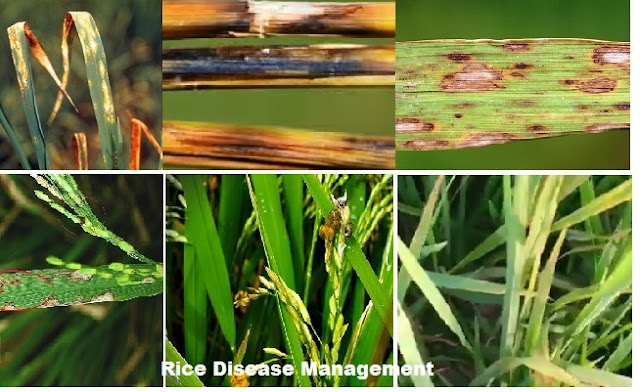





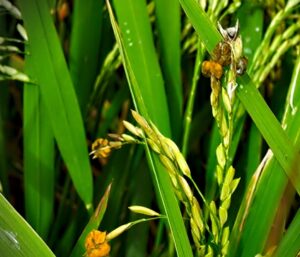
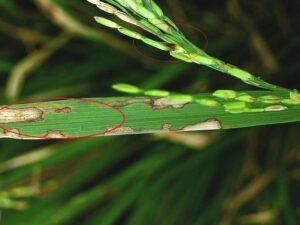
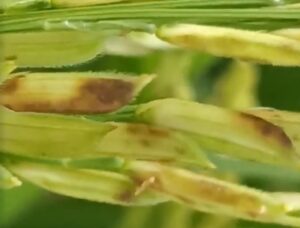
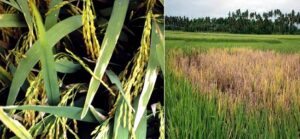

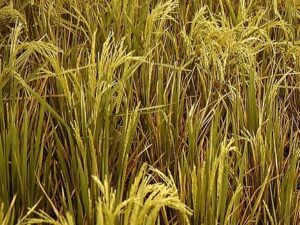


Pingback: Dry or Semi Dry Upland Rice Cultivation in India - Agrovista-Farming